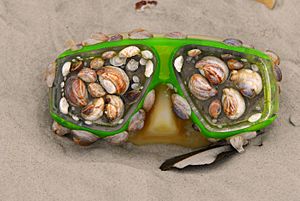Plastisphere facts for kids
The Plastisphere is a special term for tiny living communities that grow on plastic waste in our oceans. Think of it like a floating city built on plastic! All the plastic that ends up in the sea becomes a home for different kinds of tiny living things, called microorganisms. This is why scientists came up with the name "Plastisphere."
People use a lot more plastic now than ever before. Since 1964, plastic use has grown 20 times! Even though we try to recycle plastic, not much of it actually gets recycled. For example, in Europe, only about 29% of plastic is recycled. The plastic that isn't recycled often ends up in our oceans. This can happen if waste is accidentally dumped, lost during transport, or thrown directly from boats. In 2010, experts thought that about 4 to 12 million metric tons of plastic waste entered the ocean.
Plastic pollution acts like a strong "ship" for these tiny organisms. Unlike natural materials that break down quickly, plastic can float for a very long time. This allows microbes to travel long distances to new places. Sometimes, this can even introduce invasive species or harmful algae to new ecosystems. The microorganisms found on plastic trash include autotrophs (which make their own food), heterotrophs (which eat other things), and symbionts (which live closely with other organisms). The Plastisphere is different from other natural floating things like feathers or algae because plastic breaks down very slowly. Besides microbes, some insects, like the sea skater, have also started living and reproducing on the hard surfaces of floating plastic. These areas were once empty in the ocean.
Contents
Discovering the Plastisphere
The Plastisphere was first described by a team of three scientists. They were Dr. Linda Amaral-Zettler, Dr. Tracy Mincer, and Dr. Erik Zettler. They collected plastic samples during their research trips to learn how these tiny organisms live and change the ocean environment.
How Scientists Study It
The researchers gathered small pieces of plastic from many different spots in the Atlantic Ocean. They used special nets to collect these samples. To see what was growing on the plastic, they used powerful tools. They looked at the plastic surfaces with a scanning electron microscope. They also used advanced DNA sequencing to identify thousands of different organisms. These organisms were unique and different from those found in the natural ocean environment.
One interesting discovery was "pit formers." These are tiny organisms that create cracks and pits in the plastic. Scientists think these pits might be a sign that the plastic is starting to break down. These pit formers might even help break down hydrocarbons, which are chemicals found in oil. The scientists also found bacteria from the genus called Vibrio. This group of bacteria includes the one that causes cholera and other stomach problems. Some Vibrio species can even glow! It's thought that this glow might attract fish, which then eat the organisms on the plastic. The fish then become food for other animals.
Recent Research
Since the Plastisphere was discovered, many studies have been done. A lot of research shows that the Plastisphere has a very high diversity of microbes. Other scientists have looked beyond just identifying the microbes. For example, one study in the South Pacific Ocean checked if the Plastisphere contributed to greenhouse gases like CO2 and N2O. They found a low contribution, but it depended on the type of plastic and how many nutrients were present. Another study found that blue plastic pieces tended to attract the most unique microorganisms.
Microbes That Eat Plastic
Some of the tiny organisms in the Plastisphere might be able to break down plastic materials. This could be a good thing! Scientists hope to use these microbes to help clean up plastic that would otherwise stay in our environment for hundreds of years.
However, there's also a concern. When plastic breaks down into smaller pieces, it becomes microplastics. These tiny pieces are more likely to be eaten by very small ocean creatures like plankton. Once plankton eat the plastic, it can enter the food chain. As larger animals eat the plankton, the plastic can build up in fish that humans eat. This process is called bioaccumulation.
Organisms and Their Plastic-Eating Abilities
Here are some microorganisms that have shown they can break down plastic:
| Microorganism | Plastic type | Degradation Capacity |
|---|---|---|
| Aspergillus tubingensis | Polyurethane | Broke down 90% within 21 days |
| Pestalotiopsis microspora | Polyurethane | Broke down 90% within 16 days |
| Bacillus pseudofirmus | LDPE | Broke down 8.3% over 90 days |
| Salipaludibacillus agaradhaerens | LDPE | Broke down 18.3% and 13.7% after 60 days |
| Tenebrio molitor larvae (mealworms) | Polystyrene (PS) | Broke down plastic twice as fast when their diet was 10% PS and 90% bran, compared to just PS |
| Enterobacter sp. | Polystyrene (PS) | Broke down a maximum of 12.4% in 30 days |
| Phanerochaete chrysosporium | Polycarbonate | Broke down 5.4% in 12 months |
| Marine micro-bial consortium | Polycarbonate | Broke down 8.3% in 12 months |
| Ideonella sakaiensis | PET | Broke down completely within six weeks |
| Activated sludge | PET | Broke down up to 60% within a year |
| Galleria mellonella caterpillars | Polyethylene | Broke down 13% within 14 hours |
| Zalerium maritimum | Polyethylene | Broke down 70% within 21 days |
Often, the process of microbes breaking down plastic is quite slow. However, scientists are working on ways to make these organisms better at it. They are trying to genetically modify them to increase their plastic biodegradation potential. For example, Ideonella sakaiensis has been changed to break down PET plastic faster. Scientists are also trying different treatments, like UV light or c-ray radiation, to help plastics break down more easily.
See also
- North Pacific Gyre
- Garbage patch
- Plastic pollution
External Links
- In Spanish: Plastisfera para niños


